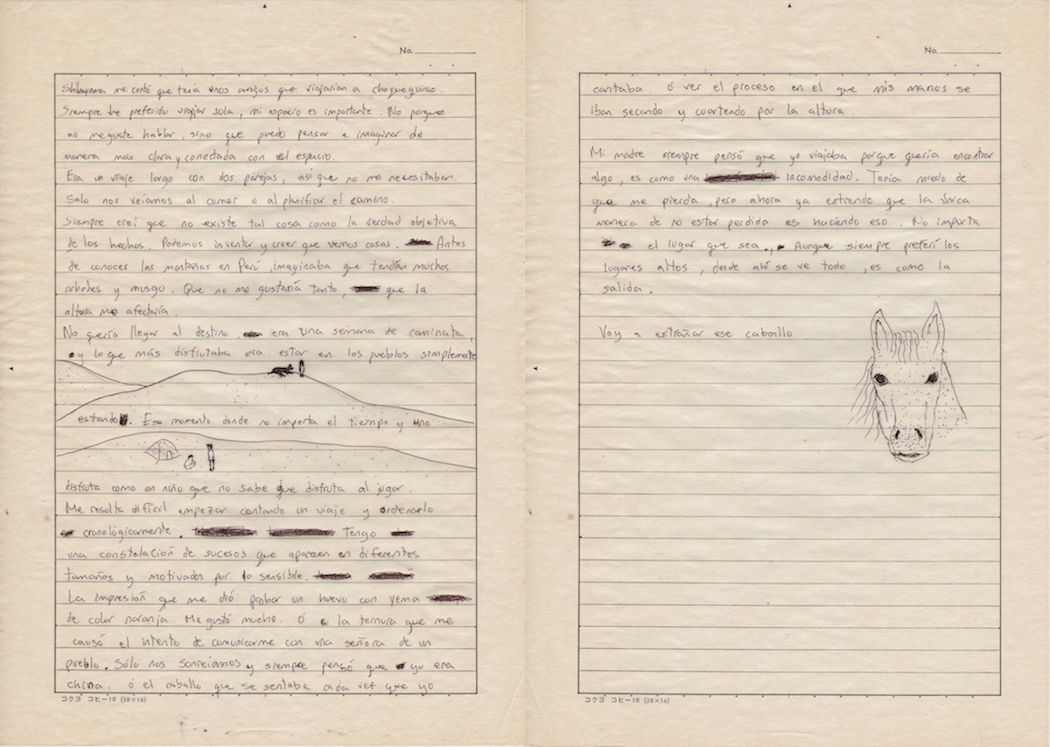news | introduction | experiments | exhibitions | CV | contact 2016/2024, travel, oral narration, hand-written journal, oblivion, recollection Installation views at MTRL KYOTO 
It led to a terrible experience. At that time, I was living in Lima, the capital of Peru, when a friend of mine said to me: "My friend is planning a trip to the ruins of Choquequirao and is looking for companions. Are you interested? I can’t go myself, but it’s a place you might like – some people call it the ‘Second Machu Picchu’ and it lies beyond the deepest canyon in the world." He knew that ruins in remote areas had always fascinated me and I had some romantic feelings about it. I preferred to travel alone basically, but this particular ruin was said to be in such an intricate location that it would be difficult for a foreigner to reach alone, so I reluctantly joined the plan. To plan the trip, I met his friends (a man and a woman) once in Lima, and a few days later, we set out. But I shouldn’t have gone. Their sensibilities, interests, and motivations for traveling were completely different from mine, and we couldn’t carry on a fun conversation. They were good people, but we just didn’t click at all. Our group was dysfunctional. For a week, we traveled with a local guide and a mule to carry our gear. I got along quite well with the mule, and after a while, I started leading it myself, and walking just on my own, even without the guide. To this point, the man and woman I was with seemed to have become closer and much more intimate, which finally turned me off completely. The night before reaching the ruins, we camped in the garden of a local villager’s house, about five kilometers from the site. I lay alone in my sleeping bag, gazing at the stars, humming a song (probably by The Blue Hearts), when the mule came over and snuggled close, keeping me warm. Leaning against the mule, I spent the most relaxing moment of the trip. The mule soon fell asleep. The next morning, I no longer felt like going to the ruins with them, so I stayed behind in the garden. Even though I had crossed the deepest canyon in the world, my deflated spirit kept me from moving forward. While I spent the day playing with the numerous chickens, the woman of the house, who had been watching me curiously from afar, eventually came over and offered me breakfast: boiled eggs, bread, and a strange drink (probably very weak coffee). As we ate breakfast together, the woman, who was around my age, fed the chickens while telling me about her daily life and the problems the village was facing. Although Quechua had long been spoken there, she hoped her children would become more fluent in Spanish than Quechua, so they could leave the mountains, find work in the city, and lead happy lives. Our house and livestock will have to end with our generation, she said. At this very moment I realized: it was in order to spend this morning with these people this way that I had come here. So I had no regrets about not going to the ruins. I think you had a good journey; if you ever want to return, just contact me, the guide said, handing me a note with the travel route and his contact information. This is the memory of my trip to Choquequirao, as it remains with me today. I’ve now managed to turn it into something of a pleasant story, but right after the trip, I couldn’t get over my frustration with the couple who traveled with me. The small troubles that are inevitable on trips only served to bring them closer together as a couple, as if we were in a cheap reality dating show. I didn’t understand what I was putting up with and felt uncomfortable. When I returned to Lima, many people expected stories about the trip, but being young and immature, I was afraid that if I talked about it, my frustration with the couple would spill out as well. I knew I should stay silent until the heat of those negative feelings subsided, but I didn’t want to forget the beautiful things I had seen. So - I decided to put this memory in a time capsule, so to say. Process: 1. Invite a close friend to your house and talk about your trip all night, focusing mainly on the memories you wanted to preserve. 2. The next morning, have that friend write a journal of the trip for you. 3. Seale the journal and silence your memory of the trip. In short, I entrusted the editing of the travel story to a third party, my friend F, who had no emotional attachment to it, and told him, my editor, only a selection of mostly happy and funny episodes that I wanted to be part of the story. Later, I moved out of Peru and began staying in different countries for artist residencies while being based in Japan. But then many things happened and eventually, I settled in Belgium. During those moves, I lost track of the journal my friend had written. I kept faithful to my promise of silence, and the experience gradually faded from the memory of my brain. In November 2023, I unexpectedly reunited with the journal. I read it. The content my friend F had written was abstract and somewhat unclear, but the good emotions from that time had been preserved in it, and I was able to touch them again. I’m glad I didn’t let my negative emotions turn the experience into a tale of nothing but frustration with incompatible travel companions, thus brainwashing myself into thinking it was a miserable trip. A negative memory from the past has been updated with a heart warming story.   where we set up our encampment |